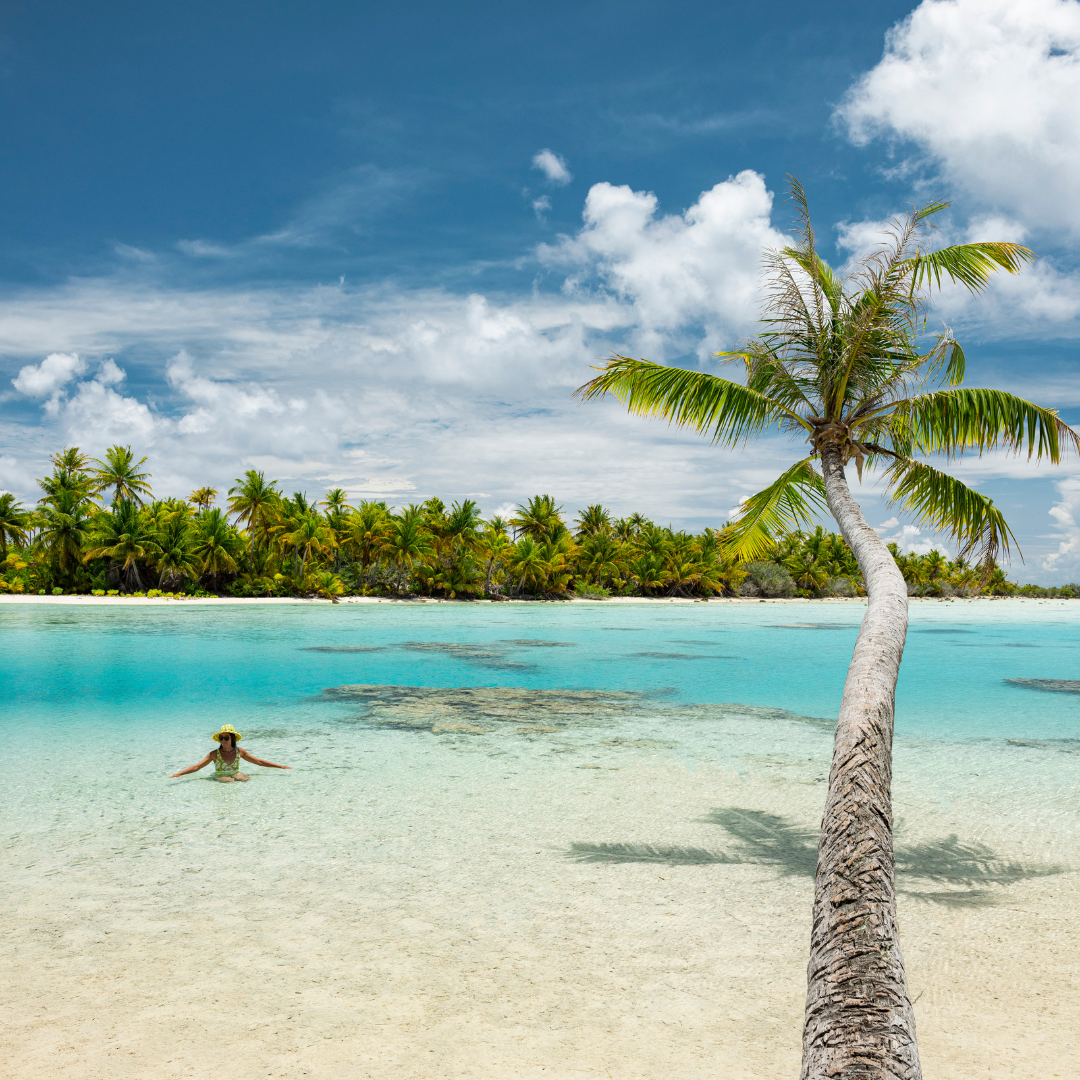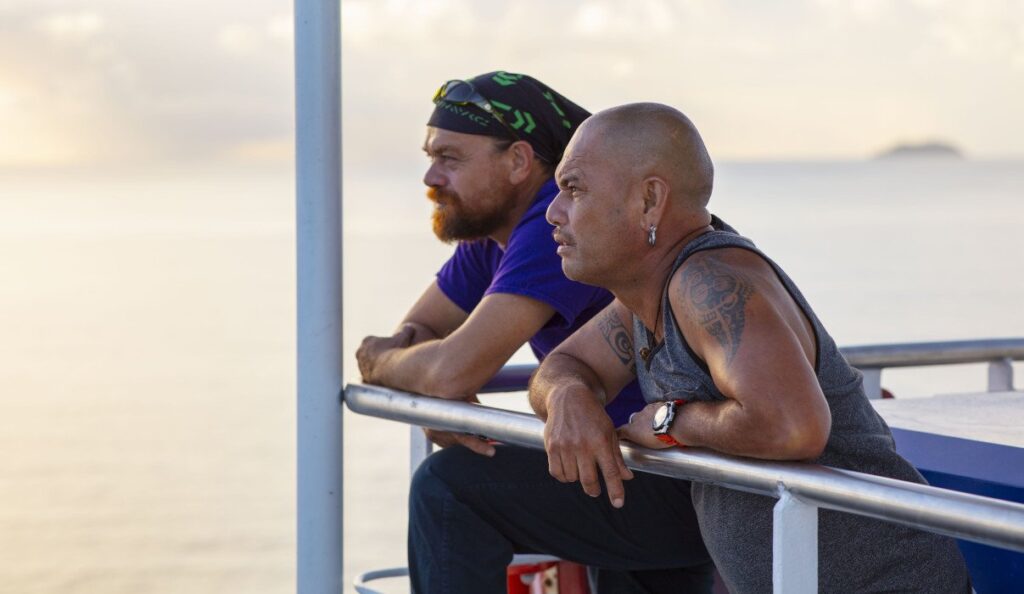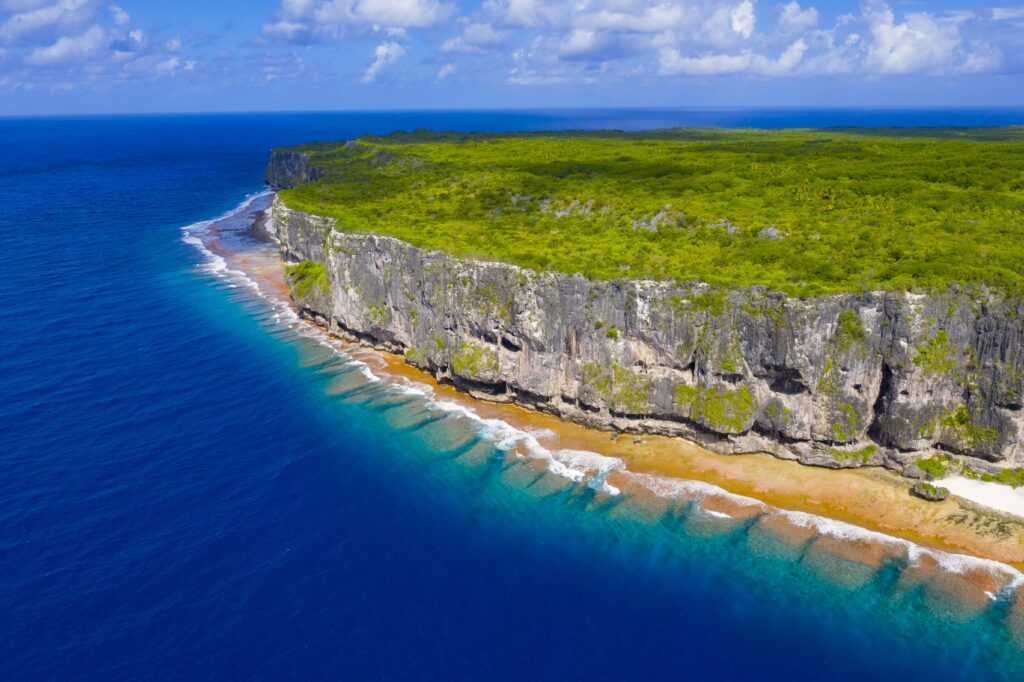Tuamotu Islands
Tuamotu Islands
It took explorers and sailors nearly three centuries to list all the 78 atolls that make up the Tuamotu Archipelago.
5 days / 4 nights

Cruise in the tuamotu: lagoons and coconut trees
uspended between the sky and the sea, the Tuamotu atolls are today synonymous with escape and paradise. And for visitors looking for an complete change of scenery and fabulous lagoons, these islands are the perfect location! Long considered dangerous for its low altitude islands, currents, reefs awash, and narrow passes. sailing in to the Tuamotu waters is indeed a delicate procedure with many obstacles to overcome before entering the magical turquoise lagoons! Today, however, with airline transportation, one can very easily reach many of these previously inaccessible rings of coral.
In Polynesian mythology, one legend tells the story of the god Tukerai who shook the sea, and is said to have scattered the string of 78 motu (islets) of the archipelago over 800,000 km² of ocean, with only 880 km² of land. The historic past of the Tuamotu is still unclear. The atolls could have been colonized from Tahiti and the Marquesas around 1000 AD, but the precise origin of the inhabitants and the settlement periods are not entirely clear.
In 1521 Magellan sailed through the maze of awash islands and reached Pukapuka, the first Pacific atoll discovered by Europeans! They were mapped by the Portuguese Quiros in 1605, and the Tuamotu islands were later named the “Dangerous Archipelago” by Bougainville because of the many shipwrecks caused by reefs. Between 1770 and 1810, almost thirty vessels crashed on these treacherous coral reefs! It took nearly three centuries for navigators to list all of the 78 atolls that make up the archipelago, none of them having spent much time among these islands that held no economic interest. For a long time, the archipelago was called Pa’umotu (“Low Islands”) and since the middle of the last century, the Tahitian name “Tuamotu” has prevailed.
With large coconut plantations, established from the 19th Century onwards, the economy of this archipelago is largely based on copra cultivation (copra is shipped to Tahiti for the manufacture of coconut oil). The cultivation of the black pearl has profoundly changed the Paumotu way of life. The Tuamotu Islands are now a must-see destination for all lovers of water sports with many activities on offer, including scuba diving in Rangiroa and Fakarava.
Stopovers
All our Marquesas cruises will sail through the atolls of Fakarava and Rangiroa (or Makatea).

Rangiroa, a wonderful lagoon in the Tuamotu Islands
In Tahitian, Rangiroa is also called Ra’iroa, meaning “immense sky” and for good reason. With a circumference of 280 km around a lagoon that is 77 km long and 26 km wide, it is the largest atoll of Polynesia. It is also the second largest in the world by the size of its lagoon, and could contain all of Tahiti and its peninsula! Located about 350 km northeast of the island of Tahiti, Rangiroa consists of nearly 250 islets separated by hōā, shallow channels between the ocean and the lagoon, with two passes in and out of the lagoon at Tiputa and Avatoru. Around the passes are gathered most of the 2500 inhabitants and key infrastructure such as the airport, wharfs and hotel facilities. While Rangiroa was spotted in 1616 by Dutch navigators Le Maire and Schoutter, traces of settlement and pre-European civilizations that managed to thrive on this atoll are still present in the form of relics such as marae. Much later, the first Europeans to settle there permanently were Catholic missionaries, in around 1860. Today tourism, copra harvesting and fishing are the main activities of Rangiroa, which is also renowned for its rich marine life, and world-renowned diving sites.

Makatea, the coveted island
Located 210 km northeast of Tahiti, this island has a special “at the edge of the world” atmosphere. Only accessible by sea, it reveals itself, like a fortress standing on the ocean and discovering Makatea aboard the ship Aranui 5 is a revelation. Following an exodus of people in the 20th century this raised atoll now has only 94 inhabitants, who remain on the island they love to continue its special story. This began at the end of the 19th century when large quantities of phosphate were discovered on the atoll and lead to Makatea’s unique industrial destiny in Polynesia. The island, forgotten up until then by the modern world, was equipped with schools, a cinema, religious centres, and various industrial installations, including a metal pier of 100 m and even a railway that is, still today, a silent testimonial to the singular history of the island.

Fakarava, a UNESCO classified corner of paradise
Fakarava, 488 km northeast of Tahiti, is an immense atoll (Tuamotu’s second in size): 60 km long and 25 km wide. Two passes provide access to the ocean, among which the Ngārue pass, the largest in Polynesia is home to most of the 800 inhabitants. A small minority of the population settled in the tiny village of Tetāmanu in the far south. Life is organized around the lagoon, with its lavish seabed. Since 2006, Fakarava, along with its six neighbouring atolls (Taiaro, Tōau, Aratika, Kauehi, Nīau and Rāraka), has been part of a UNESCO “biosphere reserve”, due to its abundance of rare flora and a fauna including hunting kingfisher, Tuamotu palms, squills and sea cicadas. The designation is part of an international sustainable development project, combining the search for harmony between human activities and nature conservation. The main resources of the island are pearl farming, fishing, copra and tourism.

Anaa
437 km away from Tahiti, Anaa has a magnificent coral ring that emits an oval jade coloured translucent and shallow lagoon, making it one of the most perfect atolls in the Pacific. Eleven small motu, with no passes and marked by the presence of feo, coral blocks emerges up to 3m high. It is home to just a 1000 people, mostly living in Tukuhora. Aranui passengers will enjoy a few days of quiet, happy and timeless life on the island en route to Pitcairn.

Kauehi
40 km northeast of Fakarava, Kauehi was not inhabited until recently. The atoll was slowly populated for the production of copra and in the past few years pearl farming also began. Opened through its only small Arikitāmiro pass to the ocean, you can reach the village of Tearavero, where most of the 250 people reside. Recently opened to tourism, Kauehi will seduce you with its authenticity, as well as with the surreal colors of the lagoon, which can be enjoyed as unique in the world!
Itineraries | Schedule | Cabin & Rates
Day 1
Departure from Tahiti (Papeete)
Departure from Papeete, welcome of our crew and navigation to the Tuamotu archipelago.

Day 2
Makatea
Surrounded by sheer cliffs rising nearly 240 feet above sea level, Makatea is the only atoll in the Tuamotu Islands with potable water, which comes from its underground caves. Once a prosperous atoll due to the exploitation of phosphates from 1917 until 1964, it has become almost completely deserted, with only a few families left. Today, the inhabitants live from copra cultivation, fishing and
the trade of the coconut crab, the “Kaveu”.Aranui offers the opportunity to visit the remains of Makatea’s past and its phosphate mining.
Passengers will disembark by tender at the Temao wharf and begin the journey across the island on foot or by car. Visit the sacred caves of Makatea and picnic under the cliffs or on the beach.

Day 3
Mataiva
Mataiva has everything to dazzle travelers. Its unique lagoon and white sand beaches make it one of the most sumptuous atolls in French Polynesia. Mataiva, which is easily accessible from Tahiti, has preserved its authenticity and tranquility. Here, there is little tourism, and the inhabitants are welcoming, kind and warm.
Passengers will disembark by tender at the Pahua wharf and will be greeted by a performance of “Orero”. The village is a 5-minute walk from the dock, and you can visit it at your own leisure.
Optional excursions will be offered such as the visit of the “Turtle Rock”, the “Paure” marae, the phosphate pond, the bird motu and the “pito” of Mataiva (sign-up at the reception). 4×4 vehicles will take you to a private beach for a picnic and to enjoy the lagoon.

Day 4
Anaa
Anaa, the birthplace of Tahiti’s royal family, the Pomare dynasty, has entered the history books.
Today, Anaa is best known for its sparkling green jade lagoon and the picturesque white sand motus surrounding it. Most of the population is engaged in copra oil production or fishing, which has led to the development of the island’s sustainable fishing program. Look out for the “feo”, the gigantic, fossilized coral blocks that are characteristic of the atoll.
Passengers will disembark by tender at the Tukuhora pier. By bus or on foot, they will be able to visit the village and its specificities. The shallow, translucent lagoon is ideal for fly fishing, an activity offered at Anaa. A picnic lunch is offered on the beach in Tukuhora village.
Optional activities: discovery and swimming at the pito “Ogoogo”.

Day 5
Tahiti (Tautira - Papeete)
Tautira means “the mast of a double hull canoe laid on the ground”. Commune located on the isthmus of the island of Tahiti. It is part of the Commune of East Taiarapu, which includes Tautira, Faaone, Afaahiti (Taravao) and Pueu. It was for a long time one of the most important districts of Tahiti with Vehiatua as its chief, who proclaimed the independence of East Taiarapu in 1768 and
who led his commune to gain supremacy over the whole island in 1773.
Passengers will disembark by tender at the Vereiti site where the band Pepena will perform for a local atmosphere. They will be able to snorkel at the beach, visit a taro factory located at a 5-minute walking distance and enjoy going to the river. Departure of the excursions to the “Te Pari” at the Vereiti pontoon (sign-up at the reception). The “maa Tahiti” will be served following the return of the
excursions.
This is the end of our journey. It’s time to say Nānā! (Goodbye) to your travel companions, to the Polynesian staff and Aranui guides.

Tuamotu Islands - 2026
| Cruise #10 | Friday 22 May – Tuesday 26 May |
Presidential Suite
- Sky deck - 9
- 41 m²
- 1 to 3 adults
Composed of three individual rooms of 41 m² interior area and a private balcony of 12 m², this outdoor cabin has a separate bedroom with a large double bed, a living room with a sofa bed, a living room with integrated bar, two bathrooms with shower and hairdryer, dressing room, refrigerator and safe.
Royal suite
- Pool deck - 7, Sun deck - 8
- 22m²
- 1 to 3 adults
This 22 m² outdoor cabin with a 9 m² private balcony features a bedroom with a king-size bed and a living area with a sofa bed, separated by a decorative Polynesian-style partition. The cabin also includes a bathroom with a shower and hair dryer, as well as a refrigerator and safe.
Royal Suite View Obstructed
- Boat deck - 5
- 22m²
- 1 to 3 adults
This outdoor cabin of 22 m² with private balcony of 9m² has a bedroom with a large double bed and a living room with a sofa bed separated by a decorative partition of Polynesian style, a bathroom with shower and dryer hair, refrigerator and safe.
Premium Suite
- Pool deck - 7, Veranda deck - 6
- 19m²
- 1 to 3 adults
This outdoor cabin of 19 m² with private balcony of 4m² has a bedroom with a large double bed or twin beds, a living room equipped with a sofa bed, separated by a decorative partition of Polynesian style, a bathroom with shower and dryerhair, refrigerator and safe.
Junior Suite Without Balcony
- Veranda deck - 6
- 19m²
- 1 to 2 adults
This 19 m² outdoor cabin without balcony but with large windows has a bedroom with a large double bed or twin beds, a bathroom with shower and hairdryer, a refrigerator and a safe.
Junior Suite With Balcony
- Veranda deck - 7
- 16m²
- 1 to 2 adults
This 16 m² outdoor cabin with a 4 m² balcony has a bedroom with a large double bed or twin beds, a bathroom with shower and hairdryer, a refrigerator and a safe.
Superior Deluxe
- Sun deck - 8, Main deck - 3, Upper deck - 4, Sky deck - 9
- 15m²
- 1 to 2 adults
This 15 m² outdoor cabin with a private balcony of 4 m² has a bedroom with a large double bed or twin beds, a bathroom with shower and hairdryer, a fridge and a safe.
Deluxe
- Sky deck - 9, Pool deck - 7, Sun deck - 8
- 13m²
- 1 to 2 adults
This 13 m² outdoor cabin with a private balcony of 4 m² has a bedroom with a large double bed or twin beds, a bathroom with shower and hairdryer, a fridge and a safe.
Stateroom
- Boat deck - 5, Lower deck - 2, Sun deck - 8, Main deck - 3
- 11m²
- 1 to 2 adults
This 11 m² outdoor cabin with porthole has a large double bed or 2 single beds and a private bathroom with shower and hairdryer.
Stateroom quadruple
- Lower deck - 2
- 17m²
- 1 to 3 adults
This four-bed cabin, 17 m², has a large double bed, two bunk beds and a private bathroom with shower and hairdryer. The displayed fare applies to the first two occupants of the cabin. The third and fourth occupant benefit from a 25% discount.
Single Stateroom
- Lower deck - 2
- 9m²
- 1 to 1 adults
This 9 m² cabin with porthole has a single bed and a private bathroom with shower and hairdryer.
Stateroom Obstructed View
- Lower deck - 5
- 11m²
- 1 to 2 adults
This outdoor cabin of 11 m² with obstructed porthole has a bed in large double bed or 2 single beds, a bathroom with shower and hairdryer.
Dormitory - class C - 8 beds
- Lower deck - 4
- 27m²
- 1 to 1 adults
This category of dormitory style accommodation has a space of 27 m² with 8 bunk beds, a living room, two bathrooms with shower and hairdryer.
Dormitory - class C - 4 beds
- Lower deck - 4
- 13m²
- 1 to 1 adults
The dormitory has 5 units: four units of 13 m² each that can accommodate four passengers per unit with two lower berths and two upper berths, a bathroom with shower and hairdryer and a 27 m² unit with 8 bunk beds. The 8-bed unit has a living room, two bathrooms with shower and hairdryer. This category can be mixed.
What's included
Rates include
The cruise and all related taxes (tourist tax, port, fuel, TDC), accommodation on board, 3 meals a day, a bottle of wine for 4 people for meals taken on board, lunches in local restaurants, guided excursions to remote villages and archaeological sites, cultural performances. Rates are per adult, double or single occupancy. These rates are valid at the time of publication and are subject to change with or without notice.
Rates do not include
Purchases on board, alcoholic beverages, tips, port taxes, other than those provided during the cruise and personal items.
Fuel surcharge, per person, from 125€ / 140 $ US/ 190 $ AUS/ 200 $ NZD/ 15 000 XPF.
Itinerary changes
ROUTE CHANGES
Itineraries and activities are indicative and can be modified depending on weather conditions, freight activity or availability. The CPTM is committed to the smooth running of all its cruises provided for in its publications.
It nevertheless reserves the right to modify or reduce the itinerary, or to replace an activity, a stopover or a routing by another when it deems it necessary.


